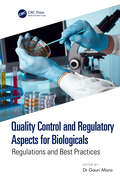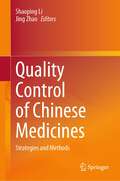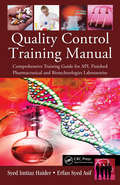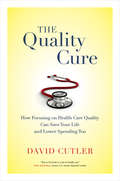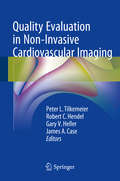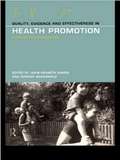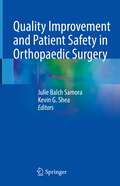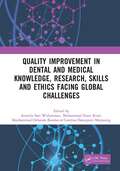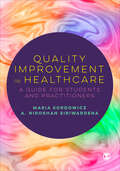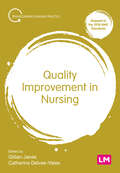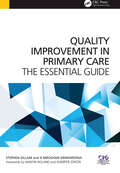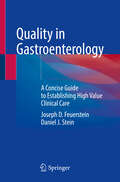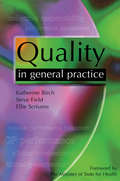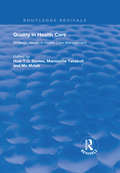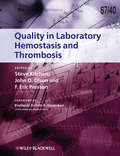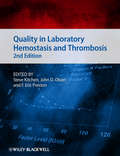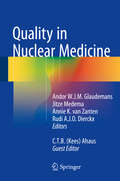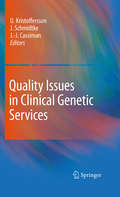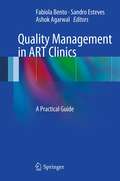- Table View
- List View
Quality Control and Regulatory Aspects for Biologicals: Regulations and Best Practices
by Gauri MisraThis book serves as a comprehensive guide on quality control and regulatory aspects for biological products. It covers a wide range of topics, including regulatory requirements, quality control strategies, analytical methods, and risk management. It delves into the advantages and limitations of in vivo tests and discusses alternative methods that can be employed. The book explores the use of animal-based testing methods in quality control and examines viable alternatives.Key Features: Reviews various scientific and regulatory aspects involved in the quality control of biologicals Provides an overview of the roles of various national and international regulatory bodies and accreditation agencies Presents advanced analytical methods, innovative technologies, and the integration of molecular diagnostics in quality control processes Explores the use of animal-based testing methods in quality control, as well as their alternatives Discusses guidelines and methodologies involved in the development of biological products Overall, this book is an important reference source for various professionals in the pharmaceutical industry, including researchers, scientists, quality control personnel, and regulatory affairs professionals.
Quality Control in the Assisted Reproductive Technology Laboratory (Reproductive Medicine and Assisted Reproductive Techniques Series)
by Durai PThis guide provides an overview of quality control in ART laboratories. It explores frameworks and essential tools necessary for effective quality management. The fields of monitoring, equipment maintenance, and the intricate aspects of embryo care and cryopreservation are thoroughly examined. The significance of the ART lab witnessing system is highlighted, demonstrating the seamless integration of both manual and electronic witnessing tools. Readers will gain insights into the roles played by KPIs and SOPs. For aspiring embryologists, this guide offers an exploration of training techniques, addressing the inherent challenges of the field. Practical coping strategies are provided to help navigate these stressors successfully.With real-world case studies and discussions on laboratory design, this resource serves as a guide to achieving excellence in ART. It emphasizes the importance of balancing patient care, procedural accuracy, and practitioner well-being.
Quality Control of Chinese Medicines: Strategies and Methods
by Jing Zhao Shaoping LiThis book focuses on the strategies and methods for quality control of Chinese medicines used in prevention and treatment of diseases for thousands of years in China and East Asia. It explains various strategies and methods for quality markers discovery and herbal glycoanalysis, as well as practices for control of heavy metal and pesticide residues. Strategies to overcome the shortage of reference compounds for quality control of Chinese medicines are also provided. The book also introduces analytical techniques for different analytes in Chinese medicines with an emphasis on sample preparation in automation and high extraction efficiency methods, the key process affecting the time and accuracy of the techniques. It is of interest to quality control scientists in academia and industry working on Chinese medicines and/or herbal medicine and also pharmacists, pharmacologists, food chemists, and nutritionists who want to understand Chinese medicines.
Quality Control Training Manual: Comprehensive Training Guide for API, Finished Pharmaceutical and Biotechnologies Laboratories
by Syed Imtiaz Haider Syed Erfan AsifWritten to help companies comply with GMP, GLP, and validation requirements imposed by the FDA and regulatory bodies worldwide, Quality Control Training Manual: Comprehensive Training Guide for API, Finished Pharmaceutical and Biotechnologies Laboratories presents cost-effective training courses that cover how to apply advances in the life sciences to produce commercially viable biotech products and services in terms of quality, safety, and efficacy. This book and its accompanying downloadable resources comprise detailed text, summaries, test papers, and answers to test papers, providing an administrative solution for management. Provides the FDA, Health Canada, WHO, and EMEA guidelines directly applicable to pharmaceutical laboratory-related issues Offers generic formats and styles that can be customized to any organization and help management build quality into routine operations to comply with regulatory requirements Contains ready-to-use training courses that supply a good source of training material for experienced and inexperienced practitioners in the biotechnology/biopharmaceutical industries Includes downloadable resources with downloadable training courses that can be adopted and directly customized to a particular organization Supplies ready-to-use test papers that allow end users to record all raw data up to the issuance of the attached certificate The biotechnology/bioscience industries are regulated worldwide to be in compliance with cGMP and GLP principles, with particular focus on safety issues. Each company must create a definite training matrix of its employees. The training procedures in this book enable end users to understand the principles and elements of manufacturing techniques and provide documentation language ranging from the generic to the specific. The training courses on the downloadable resources supply valuable tools for developing training matrices to achieve FDA, Health Canada, EMEA, MHRA UK, WHO, and GLP compliance.
The Quality Cure
by David CutlerIn the United States, the soaring cost of health care has become an economic drag and a political flashpoint. Moreover, although the country's medical spending is higher than that of any other nation, health outcomes are no better than elsewhere, and in some cases are even worse. In The Quality Cure, renowned health care economist and former Obama advisor David Cutler offers an accessible and incisive account of the issues and their causes, as well as a road map for the future of health care reform--one that shows how information technology, realigned payment systems, and value-focused organizations together have the power to resolve this seemingly intractable problem and transform the US health care system into one that is affordable, efficient, and effective.
Quality Evaluation in Non-Invasive Cardiovascular Imaging
by Peter L. Tilkemeier Robert C. Hendel Gary V. Heller James A. CaseThis handbook provideshospitals, clinics, and imaging centers, along with their medical and technicaldirectors and hospital administrators, with the necessary information and toolsto develop quality initiatives. The specific aims of this book include: 1. Describe quality control as it relates tonon-invasive cardiovascular imaging 2. Understand the current standards as published by societal guidelines oraccrediting organizations e. g. American College of Radiology (ACR),Intersocietal Accreditation Commission (IAC), The Joint Commission (TJC) or theEuropean Society of Cardiology (ESC). 3. Demonstrate techniques to comply with theroutine quality assessment of the equipment utilized in the imagingprocess. 4. Understand and document the appropriatepatient and protocol selection. 5. Optimize appropriate imaging techniques tominimize acquisition and processing artifact. 6. Improve the reporting process and moreeffectively communicate with referring physicians. 7. Assess the current process of care anddocument the outcomes to allow for process improvement. 8. Developprotocols for the evaluation of patient and physician satisfaction. 9. Design programs to perform the publicreporting of outcomes.
Quality, Evidence and Effectiveness in Health Promotion: Striving For Certainties
by John Kenneth Davies Gordon MacdonaldQuality, Evidence and Effectiveness is unique in bringing together, for the first time, the critical concepts of quality assurance and effectiveness in relation to health promotion and research.Contributions from leading health promotion specialists around the world discuss how best to push forward evidence of the value of health promotion as an effective investment strategy. They examine particular examples of health promotion interventions, focusing on both practical suggestions and the concepts underlying them.Contributions are divided into three core sections:* the examination of effectiveness studies through the application of different evaluation methodologies * practice-based quality assurance programmes * the examination of examples of health promotion interventionsQuality, Evidence and Effectiveness will be invaluable to students, researchers and policy-makers in health promotion and all professionals who are committed to the effective and efficient delivery of New Public Health.
Quality Improvement and Patient Safety in Orthopaedic Surgery
by Julie Balch Samora Kevin G. SheaThis practical, unique textbook provides a foundation for the essential elements of patient safety and quality improvement (QI) for orthopaedic trainees, though the content covered will be of interest to veteran clinicians as well. Currently, there are few existing resources and didactics focused on this crucial yet often overlooked area of medical practice, which makes this the first true textbook on the subject within the field of orthopaedic surgery. Utilizing a user-friendly approach including generous figures, tables, and bulleted key points, the text presents comprehensive background information on QI principles, models, and patient safety. More specifically, it focuses on orthopaedic concerns, such as biologics and implants, registries, checklists, surgical site infection risk reduction, use of evidence-based medicine and care maps, simulation to improve care, and shifting from volume to value, among others. Related topics such as diversity and inclusion, provider wellness strategies, leadership strategies to develop an efficient and safe work culture, and innovation are also presented. Throughout, the aim is to demonstrate that QI is a multidisciplinary goal that can only flourish in an environment of supportive accountability. With contributions by leaders in the field, Quality Improvement and Patient Safety in Orthopaedic Surgery provides trainees and surgeons in the field a valuable and pragmatic toolkit for successful and sustainable clinical practice.
The Quality Improvement Challenge: A Practical Guide for Physicians
by Richard J. Banchs Michael R. PopEfforts to improve the quality of healthcare have failed to achieve a meaningful and sustainable improvement. Patients continue to experience fragmented, inconvenient, and unsafe care while providers are increasingly becoming overburdened with administrative tasks. The need for change is clear. Healthcare professionals need to take on new leadership roles in quality improvement (QI) projects to effect real change. The Quality Improvement Challenge in Healthcare equips readers with the skills and knowledge required to develop and implement successful operational improvement initiatives. Designed for healthcare providers seeking to apply QI in practice, this valuable resource delivers step-by-step guidance on improvement methodology, team dynamics, and organizational change management in the context of real-world healthcare environments. The text integrates the principles and practices of Lean Six Sigma, human-centered design, and neurosciences to present a field-tested framework. Detailed yet accessible chapters cover topics including identifying and prioritizing the problem, developing improvement ideas, defining the scope of the project, organizing the QI team, implementing and sustaining the improvement, and much more. Clearly explaining each step of the improvement process, this practical guide: Presents the material in a logical sequence, gradually introducing each step of the process with clearly defined workflow templates Features a wealth of examples demonstrating QI application, and case studies emphasizing key concepts to highlight successful and unsuccessful improvement initiatives Includes end-of-chapter exercises and review questions for assessing and reinforcing comprehension Offers practical tips and advice on communicating effectively, leading a team meeting, conducting a tollgate review, and motivating people to change Leading QI projects requires a specific set of skills not taught in medical school. The Quality Improvement Challenge in Healthcare bridges this gap for experienced and trainee healthcare providers, and serves as an important reference for residency program directors, physician educators, healthcare leaders, and health-related professional organizations.
Quality Improvement in Dental and Medical Knowledge, Research, Skills and Ethics Facing Global Challenges: Proceedings of the International Conference on Technology of Dental and Medical Sciences (ICTDMS 2022), Jakarta, Indonesia, 8-10 December 2022
by Armelia Sari Widyarman Muhammad Ihsan Rizal Moehammad Orliando Roeslan Carolina Damayanti MarpaungThe proceeding of FORIL XIII 2022 Scientific Forum Usakti conjunction with International Conference on Technology of Dental and Medical Sciences (ICTDMS) includes selected full papers that have been peer-reviewed and satisfy the conference's criteria. All studies on health, ethics, and social issues in the field of dentistry and medicine have been presented at the conference alongside clinical and technical presentations. The twelve primary themes that make up its framework include the following: behavioral epidemiologic, and health services, conservative dentistry, dental materials, dento-maxillofacial radiology, medical sciences and technology, oral and maxillofacial surgery, oral biology, oral medicine and pathology, orthodontics, pediatrics dentistry, periodontology, and prosthodontics. This proceeding is likely to be beneficial in keeping dental and medical professionals apprised of the most recent scientific developments.
Quality Improvement in Healthcare: A Guide for Students and Practitioners
by Maria Kordowicz A. Niroshan SiriwardenaThis book introduces quality improvement for anyone studying or working in healthcare. Written in clear, straightforward language, it explores quality improvement from multiple perspectives and outlines a range models and toolkits you can use in practice. Encouraging you to reflect on your role as an improver, the book equips you with the knowledge and skills you need to work through each stage of the improvement process – from troubleshooting an issue, to working with others to make an improvement, through to its evaluation. Key features: - Case studies and activities help you to apply theory and methodology to your everyday role. - A comprehensive glossary introduces quality improvement terminology and concepts. - A logical four-part structure moves from the basics up, building your knowledge and understanding as you go.
Quality Improvement in Healthcare: A Guide for Students and Practitioners
by Maria Kordowicz A. Niroshan SiriwardenaThis book introduces quality improvement for anyone studying or working in healthcare. Written in clear, straightforward language, it explores quality improvement from multiple perspectives and outlines a range models and toolkits you can use in practice. Encouraging you to reflect on your role as an improver, the book equips you with the knowledge and skills you need to work through each stage of the improvement process – from troubleshooting an issue, to working with others to make an improvement, through to its evaluation. Key features: - Case studies and activities help you to apply theory and methodology to your everyday role. - A comprehensive glossary introduces quality improvement terminology and concepts. - A logical four-part structure moves from the basics up, building your knowledge and understanding as you go.
Quality Improvement in Nursing (Transforming Nursing Practice Series)
by Gillian Janes Catherine Delves-YatesAs a student and newly registered nurse, you will need to work with others to lead, improve and sustain high quality care. This book will equip you with the skills and knowledge to do just that. From the principles and theory behind quality improvement to the practical skills and tools needed to enable it, the book develops your ability to engage in continuous quality improvement in different settings throughout your career. Key features · Mapped to the 2018 NMC Standards of Proficiency · Case studies illustrate the principles of quality improvement in real examples from practice · Walks you step by step through each aspect of a quality improvement project, from identifying a need to implementation and evaluation · Personal and professional development is discussed throughout, empowering you to engage in quality improvement from the very start of your career
Quality Improvement in Nursing (Transforming Nursing Practice Series)
by Gillian Janes Catherine Delves-YatesAs a student and newly registered nurse, you will need to work with others to lead, improve and sustain high quality care. This book will equip you with the skills and knowledge to do just that. From the principles and theory behind quality improvement to the practical skills and tools needed to enable it, the book develops your ability to engage in continuous quality improvement in different settings throughout your career. Key features · Mapped to the 2018 NMC Standards of Proficiency · Case studies illustrate the principles of quality improvement in real examples from practice · Walks you step by step through each aspect of a quality improvement project, from identifying a need to implementation and evaluation · Personal and professional development is discussed throughout, empowering you to engage in quality improvement from the very start of your career
Quality Improvement in Primary Care: The Essential Guide
by Stephen GillamThis book provides readers with an invaluable set of tools to convert the endless challenges for quality and myriad opportunities for improvement into meaningful and useful change. It considers how to manage primary care organisations in order to improve quality of care; how general practices are regulated and held accountable; various techniques used for assessing and measuring; and commonly used quality improvement frameworks.
Quality in Gastroenterology: A Concise Guide to Establishing High Value Clinical Care
by Daniel J. Stein Joseph D. FeuersteinThis book is an all-in-one resource on providing and establishing high quality care in clinical gastroenterology. The text provides an in-depth analysis of not just guideline-based care, which is usually covered in shorter articles, but a combination of guidelines, quality metrics, and general standard of care in all areas of clinical practice and endoscopy. The book also covers high quality care for specific gastrointestinal disease states, such as inflammatory bowel disease, motility disorders, and pancreatic diseases, reviewing the appropriate timing of procedures for those conditions. Each chapter features a table of key quality measures for easy use and access. The chapters also discuss avoiding overuse of procedures, as well as instances where it may not be indicated to perform procedures. In addition, this volume combines the standards put forth by many different societies and groups into a single source for providers to use as a blueprint for standards of high quality care. Quality in Gastroenterology summarizes everything a practicing clinician needs for providing high quality care in one convenient place.
Quality in General Practice
by Katherine Birch Steve Field Ellie ScrivensThe recent shifts in power, resources, influence and responsibility in primary care has increased the strain on general practice. This book is a comprehensive guide to the wide range of quality schemes available. It is unique in examining quality within the context of current practice, and it discusses future options based on new examples and research. It outlines the development of clinical governance, strategies for managing and assessing quality, continuing professional development, Department of Health policy initiatives and future trends.
Quality in Health Care: Strategic Issues in Health Care Management
by Manouche TavakoliThis title was first published in 2001. Enhancing the quality of health services remains a key challenge for all health systems, whatever their stage of development. This collection of leading-edge research from Europe and America explores both quantitative and qualitative approaches to identifying and remedying deficiencies in health care.
Quality in Laboratory Hemostasis and Thrombosis
by Steve Kitchen John D. Olson F. Eric Preston"Over the last decades, major progress has been made in quality assurance of hemostatic laboratory assays. This book will be an indispensable part of every hemostasis laboratory, where, given its hands-on nature, it will rarely sit to get dusty on the shelves." —Frits R. Rosendaal, Leiden University Medical Center The hemostasis laboratory has a vital role in the diagnosis and management of patients with familial and acquired hemorrhagic and thrombotic disorders. Its role in the monitoring traditional anticoagulant therapy as well as therapy using new anticoagulants presents new challenges to the laboratory. Quality in Laboratory Hemostasis and Thrombosis not only addresses these important issues, but also covers international guidelines for testing, the development of international standard materials, management of hemostasis testing from the laboratory to the point of care as well as molecular genetic testing. Designed as a guide for all those working in hemostasis laboratories, this book details a quality program that, when put into place, will help to improve standards in testing. All of the authors are internationally recognised for their work in hemostasis and thrombosis. Using their experience, they provide information on standards, equipment and methods that will guide the development of a quality program to support all activities in the hemostasis laboratory.
Quality in Laboratory Hemostasis and Thrombosis
by Steve Kitchen John D. Olson F. Eric PrestonThe hemostasis laboratory has a vital role in the diagnosis and management of patients with familial and acquired haemorrhagic and thrombotic disorders. Its role in the monitoring of traditional anticoagulant therapy, as well as therapy using new anticoagulants, presents new challenges to the laboratory. This new edition addresses these important issues, as well as international guidelines for testing, the development of international standard materials, management of haemostasis testing from the laboratory to the point-of-care, and molecular genetic testing.
Quality in Nuclear Medicine
by Andor W.J.M. Glaudemans Jitze Medema Annie K. van Zanten Rudi A.J.O. Dierckx C. T. B. Kees AhausThis comprehensive textbook provides a state of the art overview of the means by which quality in patient care is ensured within the field of nuclear medicine. Acknowledged experts in the field cover both management aspects, such as laws, standards, guidelines, patient safety, management instruments, and organisations, and specific issues, including radiation safety and equipment. Quality in Nuclear Medicine not only presents detailed information on the topics discussed but should also stimulate further discussion and offer an important tool to all professionals in the field of nuclear medicine and their stakeholders. Readers will find that the book provides a wealth of excellent guidance and reflects the pioneering role of nuclear medicine in advancing different aspects of quality within medicine.
Quality in Obesity Treatment
by John M. Morton Stacy A. Brethauer Eric J. DeMaria Scott Kahan Matthew M. HutterThis book reviews quality definition, measurement, improvement, value, and accountability for obesity management. The interplay between quality, cost, access and satisfaction is fully depicted with a goal toward not only fulfilling current standards but also anticipating future needs. A thorough inventory of current best practices in all aspects of obesity care is cataloged with a gap analysis also employed for potential areas of improvement to be road mapped. All chapters are written by experts in their fields and include the most up-to-date scientific and clinical information, take home messages, and questions towards following the requirements of quality certification in obesity management. Quality in Obesity Treatment provides a comprehensive, contemporary review of this field and serves as a valuable resource for Bariatric Surgeons, Primary Care Physicians, Policy Makers, Insurance Administrators, Bariatricians, and any medical specialty interested in obesity quality management with likely candidates coming from GI, endocrinology, cardiology, sleep medicine and orthopedics.
Quality Issues in Clinical Genetic Services
by Ulf Kristoffersson J. J. Cassiman Jörg SchmidtkeInitially genetic disorders were all considered as rare diseases. At present, in the mid of 2009, the OMIM catalogue contains information on more than 12 000 entries of which about 2500 are available for clinical testing based on the identification of the responsible gene defect. However, altogether it has been estimated that about 8 percent of a population in the economically developed countries will during their lifetime suffer from a disease mainly as the result of their genetic constitution. Adding to that, it is estimated that all diseases have a genetic component, which will determine who will be at a higher than average risk for a certain disorder. Further it is postulated that in the near future, this genetic profiling could become useful in selecting an appropriate therapy adapted to the genetic constitution of the person. Thus, genetic disorders are not rare. Measuring quality of health care related processes became an issue in the 1990s, mainly in laboratory medicine, but also for hospitals and other health care systems. In many countries national authorities started to implement recommendations, guidelines or legal procedures regulating quality of health care delivery. In laboratory medicine, in parallel, the use of accreditation as a method assuring high quality standards in testing came in use. With the increasing possibilities of performing molecular genetic testing, genetic laboratories needed to become involved in this process. As many genetic disorders are rare, most laboratories worldwide offered analysis for a specific set of disorders, and, therefore, very early on a transborder flow of samples occurred. While international quality criteria (ISO) have been in existence for a number of years, the regulation of quality issues still may differ between countries. Based on their personal experience in the varying fields of quality research and clinical implementation of quality criteria in genetic services the authors of this book share their experience and give examples of the implementation of quality issues in national quality systems worldwide. This book, which is the result of the effort of many persons, is destined to aid laboratory managers and counsellors, health care managers and other stakeholders in national or international health care service to improve the services to the benefit of patients with suspected genetic disorders.
Quality Management and Accreditation in Hematopoietic Stem Cell Transplantation and Cellular Therapy: The JACIE Guide
by Mahmoud Aljurf John A. Snowden Patrick Hayden Kim H. Orchard Eoin McGrathThis open access book provides a concise yet comprehensive overview on how to build a quality management program for hematopoietic stem cell transplantation (HSCT) and cellular therapy. The text reviews all the essential steps and elements necessary for establishing a quality management program and achieving accreditation in HSCT and cellular therapy. Specific areas of focus include document development and implementation, audits and validation, performance measurement, writing a quality management plan, the accreditation process, data management, and maintaining a quality management program. Written by experts in the field, Quality Management and Accreditation in Hematopoietic Stem Cell Transplantation and Cellular Therapy: A Practical Guide is a valuable resource for physicians, healthcare professionals, and laboratory staff involved in the creation and maintenance of a state-of-the-art HSCT and cellular therapy program.
Quality Management in ART Clinics
by Fabiola Bento Sandro Esteves Ashok AgarwalIn the last decades, major advances have been made in assisted reproductive technologies (ART) and the public demand for these procedures has increased globally. All ART clinics, from those just starting out to the well established, must employ the latest equipment and implement the best practices, while ensuring that their resources are effectively engaged to optimize patient outcomes. This is a tenet of the fiduciary role of physicians and it is increasingly recognized as a quantifiable goal regulated by formal certifications and accreditations. Quality management protocols such as those proposed by the International Organization for Standardization (ISO) are being rapidly adopted as standards of measure. Quality Management in ART Clinics: A Practical Guide provides easily adoptable ways to implement and improve formalized quality management systems. Essential to any clinic to achieve best practices and maintenance of formal regulatory certifications, this book brings together the know-how of experienced opinion leaders operating in key areas worldwide. The book offers an overview of primary regulations in the ART field, with attention to quality management demands, and links specific requirements to practical steps for implementation. Filled with process and procedure examples, flow diagrams and administrative form templates, this book is the first of its kind, gathering the necessary elements for optimizing practice, management, and quality assurance.
